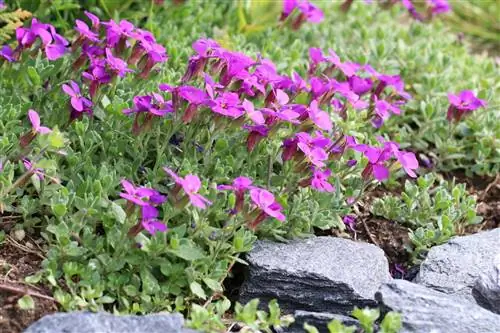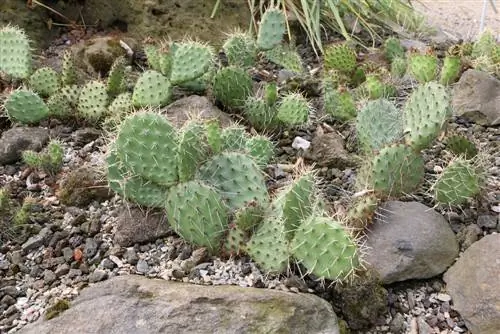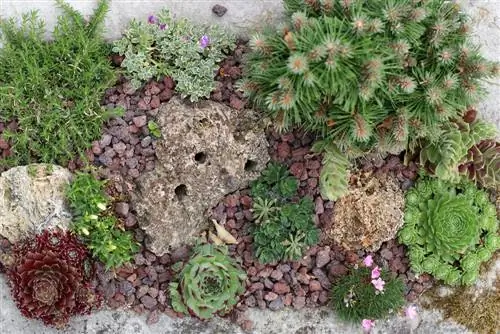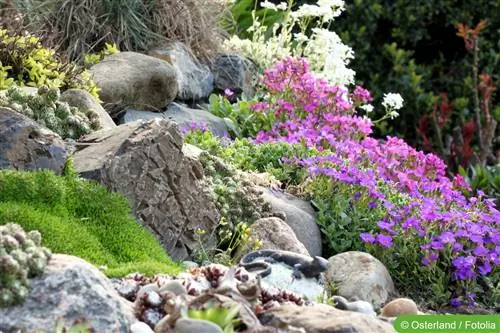- Author admin [email protected].
- Public 2023-12-17 03:39.
- Last modified 2025-01-24 12:45.
Evergreen and hardy as well as annual plants are particularly suitable for planting. Furthermore, perennials such as cushion phlox, stone phlox, blue cushions, alyssum, ornamental grasses and conifers, but also sub-shrubs such as blue rue, blue fescue and lavender are great plants that feel very comfortable in stone bones. You can also create a particularly beautiful mountain romance with alpine plants such as gentian, primroses, carnations and houseleeks. The cushion perennial is a particularly resistant plant and therefore a classic. It is herbaceous, perennial, compact and grows to around 30 centimeters high.
If you want plants with more height, choose dwarf trees or sedum plants. The so-called cat's paws, the alpine aster and the common grass are also very popular. Smaller types of bellflowers, stone crushers, gentians, fuchsias, primroses, silver thistle, purple bells, milk star, alpine rose or candytufts are also wonderful plants that look great in a rock garden. Many of the plants mentioned require heat radiation for their development and development. The stones do this, while the roots of the plants remain cool. Rockery perennials neither require nor tolerate nutrient-rich soil.
Perfect splash of color for the eye-catching rock garden
The rock garden is fascinating not only because of the diverse plants and flowers, but also because it is an eye-catcher all year round. There are many plants available, such as dwarf conifers, which are green all winter long and ensure an evergreen garden. Pops of color can be added with primrose hybrids in early spring in partially shaded locations. Their pale pink flowers offer a wonderful sight when combined with blue leather flowers. A further and additional splash of color is achieved by planting, for example, a blue cushion, which also blooms in early spring. Other frost-hardy plants include stone purse, common thrush and alyssum. Rubble stones, for example, can be used directly as plant containers. Otherwise, distribute the stones liberally throughout the garden.
Rock garden in local latitudes
Furthermore, make sure there is enough moisture in your rock garden in spring. In winter, the plants survive without liquid. Although the rock garden has the charm of a wild mountainside, make sure that you regularly remove snails, wild herbs and dead plant parts. A rock garden often forms a home for lizards, which like to make themselves comfortable in the sun on the stones and lay their eggs for their offspring under the stones that protect them.
Plants that form a so-called carpet, such as the cushion phlox, are very pretty in the rock garden. The plant spreads and generally grows quickly, meaning you can cover a large area with it within a few years. The growth height, however, is only approx. 10 to 15 cm. In spring, cushion phlox is full of small flowers that can be either red, pink, blue or white. Sunny varieties of thyme also form a beautiful carpet and are also suitable as ground cover plants.
What you should know about hardy rock garden plants in brief
The perennials, shrubs and dwarf trees in this group include a number of well-known plants that are rewarding yet undemanding:
- Blue cushion (Aubrieta)
- Sunflower (Helianthemum)
- Carnations (Armeria)
They thrive and bloom profusely when placed in full sun on well-drained soil. However, other rock garden plants have higher demands. They need well-drained soil and at the same time a satisfactory water supply and protection from excess moisture in the winter months. The most difficult species include the alpine plants of high altitudes:
- Gentiana (Gentiana)
- Primroses (Primula)
- Man's Shield (Androsace)
Between these extremes there is a wide range of different rock garden plants for hill beds, paving, a wall or even small potted gardens.
Seasons in the rock garden
- A rock garden can be an eye-catcher all year round: dwarf conifers with creeping, cushion-shaped or upright growth habits provide greenery even in winter. And houseleek species remain attractive all year round.
- In early spring and in semi-shady locations, the pale pink flowering, brown-leaved primrose hybrid 'Garryarde Guinevere' and blue liverworts (Hepatica nobilis) conjure up delicate touches of color.
- With robust, flat-spreading species such as the blue cushion, strong color spots can be created.
- The most distinctive spring bloomers include alyssum (Alyssum saxatile), alyssum (Aethionema), dwarf species and cultivars of phlox (such as Phlox douglasii) as well as the common thrush,armeria maritima.
- Even before their flowering period ends, the time of the moss-like saxifrage species begins, whose delicate white, pink or deep red flowers cover the rosette-forming leaves.
- With its pink flowers, the double squirrel Diascia cordata 'Ruby Field', which belongs to the pharyngeal family, is an ornament almost all summer long. You can extend the flowering period by cutting back the plant after the first flowering.
- Also in summer, the sun rose Helianthemu nummularium shows its attractive colors, which range from pink to yellow to deep orange and red tones.
- Other worthwhile summer bloomers are toadflax (Silene schafta) with pink flowers that delight us well into autumn, lovely blue-flowering speedwell (Veronica prosrata) and many aromatic-smelling thyme species such as Thymus praecox (syn. T. drucei).
Editor’s Tip
Once you have discovered how well the less complicated species thrive, you can confidently try rock garden plants with more demanding location requirements. Many grow in clumps or form cushions, and the foliage alone often has an ornamental effect. One of the most charming species is the pasqueflower (Pulsatilla vulgaris), so named because of the bell-like shape of its flowers. In the first weeks of spring, the finely feathered foliage appears and the furry buds unfold into light purple to purple flowers with a golden yellow center.






